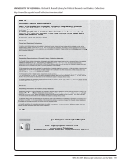SPEC Kit 307: Manuscript Collections on the Web · 95
Staffing — there is not enough staff
to handle the large accessioning and
processing backlog never mind spend
time to put information on the Web on
a regular basis.
Expertise and training — the staff who
spend time arranging and describing
manuscript collections need training
and guidance. One-on-one training
has proven the most beneficial, but
currently only the University Archivist is
able to provide this training. He does so
on an as needed basis.
Inconsistent legacy finding aids — As
we review legacy finding aids we are
discovering that some of them are
missing the important elements to put
online.
Technical support for getting all of our
finding aid container lists added to our
finding aids through implementation of
archivists Toolkit.
Human resources and financial
resources to accomplish this task in
the midst of other vital priorities such
as processing and preservation of
collections—particularly special formats
like AV and electronic records.
Greater availability means greater
usage. Having our container lists
available online will likely create an
increase in requests for materials from
offsite patrons, which will increase our
workload and require us to revisit our
policies and procedures.
Technical support. Staffing.
Technical support: available technical
support is insufficient in quantity and in
experience with EAD issues.
Time: EAD encoding and Web work
takes away from processing time.
Legacy finding aids must be updated
to meet professional standards and
repository description guidelines before
being put online.
The decentralized organization of
manuscript collections has lead to a
variety of practices and requirements
for online collection descriptions.
We currently lack centralized and
supported system architecture to
encode descriptions and provide
effective delivery and search to users.
A wide variety of legacy information, in
terms of format and content, creates a
barrier to systematic conversion.
The process is often time consuming
especially when conducting a
retrospective project for already
processed finding aids that are either
Word documents or paper documents.
Competing demands for staff time
and the increasing need to prioritize
projects.
The varying levels of technical
competence among staff members in
determining and implementing a variety
of methods to train staff on new skills.
Time. Money. Technology.
Time. Cost. Cost.
Time. Lack of inter-unit cooperation. Money.
Time away from other responsibilities—
reference, exhibitions, instruction,
outreach, donor relations, collection
development, etc. It’s hard to fit in
time to process manuscripts! Our
increased online reference service takes
away from staff time for processing
collections.
Not enough staff to write collection
descriptions. We have many collections
that have undergone little or no
processing.
Cleaning up database to be
standardized for export to XML.
Staffing — there is not enough staff
to handle the large accessioning and
processing backlog never mind spend
time to put information on the Web on
a regular basis.
Expertise and training — the staff who
spend time arranging and describing
manuscript collections need training
and guidance. One-on-one training
has proven the most beneficial, but
currently only the University Archivist is
able to provide this training. He does so
on an as needed basis.
Inconsistent legacy finding aids — As
we review legacy finding aids we are
discovering that some of them are
missing the important elements to put
online.
Technical support for getting all of our
finding aid container lists added to our
finding aids through implementation of
archivists Toolkit.
Human resources and financial
resources to accomplish this task in
the midst of other vital priorities such
as processing and preservation of
collections—particularly special formats
like AV and electronic records.
Greater availability means greater
usage. Having our container lists
available online will likely create an
increase in requests for materials from
offsite patrons, which will increase our
workload and require us to revisit our
policies and procedures.
Technical support. Staffing.
Technical support: available technical
support is insufficient in quantity and in
experience with EAD issues.
Time: EAD encoding and Web work
takes away from processing time.
Legacy finding aids must be updated
to meet professional standards and
repository description guidelines before
being put online.
The decentralized organization of
manuscript collections has lead to a
variety of practices and requirements
for online collection descriptions.
We currently lack centralized and
supported system architecture to
encode descriptions and provide
effective delivery and search to users.
A wide variety of legacy information, in
terms of format and content, creates a
barrier to systematic conversion.
The process is often time consuming
especially when conducting a
retrospective project for already
processed finding aids that are either
Word documents or paper documents.
Competing demands for staff time
and the increasing need to prioritize
projects.
The varying levels of technical
competence among staff members in
determining and implementing a variety
of methods to train staff on new skills.
Time. Money. Technology.
Time. Cost. Cost.
Time. Lack of inter-unit cooperation. Money.
Time away from other responsibilities—
reference, exhibitions, instruction,
outreach, donor relations, collection
development, etc. It’s hard to fit in
time to process manuscripts! Our
increased online reference service takes
away from staff time for processing
collections.
Not enough staff to write collection
descriptions. We have many collections
that have undergone little or no
processing.
Cleaning up database to be
standardized for export to XML.








































































































































































































